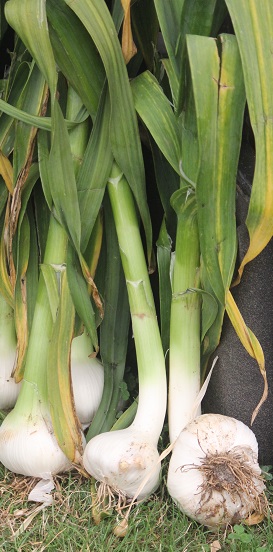Garlic
 Garlic is a hardy clump forming plant growing to 70cm high. It dies back to the bulbs in cold weather, then regrows in the warmer months. It prefers a rich, moist, fertile, sandy soil, moist but not excessively wet. It is also important to keep the soil weed free.
Garlic is a hardy clump forming plant growing to 70cm high. It dies back to the bulbs in cold weather, then regrows in the warmer months. It prefers a rich, moist, fertile, sandy soil, moist but not excessively wet. It is also important to keep the soil weed free.
Propagate by dividing the root system or cloves in early autumn or early spring. Best planted in autumn about a month before the first frosts.
Roots develop in late autumn to give the plant a head start in spring.
Plant a 4 5cm diameter clove approx. 10 12cm apart in the rows and have the rows 30 40cm apart.
Leaves and roots being high in sulphur are a natural antibiotic and can be used as a medicine (for people or animals) or a spray (for controlling fungal diseases on plants).
Production:
- Weed control is particularly important. In most large commercial crops this is achieved by careful timing of weedicide applications.
- Growers in some areas use soil and tissue culture testing to help determine the type and timing of fertilizers.
- *Seed (ie: clove) planting machines are used to plant large scale crops.
It requires approx 400 kg (900 pounds) of cloves to plant one acre
(.45 ha).
Garlic responds well to fertilizer, but does not require as heavy feeding as other crops. For high yields, the upper 60cm of soil needs to remain moist, however over watering can be disastrous. Weeds are controlled by shallow cultivation. The bulb clove development commences when the leaves stop growing. To get maximum yields, it is necessary to get maximum top growth before this point.
Seed Storage:
Cloves should be stored at 0 2 degrees celsius.
Storing at too high or low a temperature can cause side shooting and delayed maturity. A pre cooling treatment at 19 degrees celsius for two weeks will result in the plants maturing two to four weeks earlier once cloves are removed from storage and planted out.
Harvesting:
- If harvested into bins where humidity becomes too high, rot can set in.
- Care must be taken to cure and dry garlic before storage.
- Bruising can occur if harvested by machines operating at too high a speed. (or with badly designed harvesting machines).
- Varieties vary in their keeping quality
You may also be interested in....